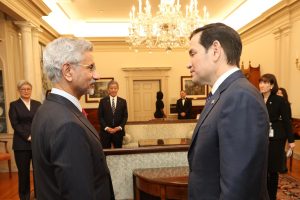New Delhi – In April 2025, diplomatic ties between India and the United States saw renewed momentum as Indian External Affairs Minister Subrahmanyam Jaishankar and U.S. Secretary of State Marco Rubio held their first official conversation following Washington’s imposition of new tariffs on Indian exports. The central theme of their exchange was the urgent need to conclude the long-pending Bilateral Trade Agreement. Both leaders emphasized their intent to expedite negotiations in the face of growing global economic uncertainties, underlining the significance of strong bilateral cooperation.
This interaction marks a pivotal step toward resolving ongoing trade frictions and reflects both governments’ desire to establish a robust framework for future economic collaboration. Their discussion covered not only tariff issues but also regional stability, technology partnerships, and supply chain diversification.
Background: Long Road to Trade Convergence
India and the United States, the world’s two largest democracies, have historically shared strong commercial ties. Trade in goods and services between the two nations surpassed $190 billion in 2023, making the U.S. India’s largest trading partner. However, despite this growing economic engagement, both sides have struggled to finalize a comprehensive Bilateral Trade Agreement.
The roots of the current effort stretch back nearly a decade. While previous administrations in both countries held several rounds of negotiations, differences over agricultural access, digital services, tariffs, intellectual property, and labor standards consistently derailed talks.
U.S. Tariffs and India’s Response

In early March 2025, the United States imposed tariffs on a range of Indian goods, citing concerns about unfair market practices and digital trade restrictions. Products affected include pharmaceuticals, textiles, and electronics, which constitute a significant portion of India’s exports to the U.S.
India, while expressing disappointment, has chosen a measured response. Instead of retaliating with counter-tariffs, New Delhi has focused on diplomatic engagement. As Jaishankar and Rubio discussed during their call, both sides acknowledged that imposing duties would not serve long-term strategic interests. Instead, they agreed that accelerated negotiations on the Bilateral Trade Agreement would be the most constructive path forward.
Strategic Importance of the Bilateral Trade Agreement


The Bilateral Trade Agreement holds immense value for both India and the U.S. Economically, it can reduce tariff and non-tariff barriers, promote innovation, and enhance investor confidence. Strategically, it symbolizes mutual trust and a commitment to rules-based trade.
For India, concluding the Bilateral Trade Agreement could enhance its “Make in India” initiative by attracting U.S. companies looking to shift manufacturing away from China. For the U.S., the agreement aligns with its efforts to strengthen economic alliances in the Indo-Pacific and reduce supply chain dependency on Chinese manufacturing.
Also Read: Breaking News: Trump Meets Netanyahu to Seek Gaza War Resolution in 2025
Technology and Digital Trade


Technology and digital services remain contentious areas in the Bilateral Trade Agreement discussions. The U.S. has pushed for greater access to India’s burgeoning digital economy, including e-commerce and cloud services. India, on the other hand, has advocated for data localization and protective measures for domestic startups.
During the call, Jaishankar emphasized India’s need for digital sovereignty, while Rubio proposed mechanisms that would allow American tech firms to operate in India without compromising Indian regulatory autonomy. A potential compromise could involve sector-specific data sharing protocols and joint tech hubs.
Agriculture and Market Access
Agriculture is another significant sticking point in the Bilateral Trade Agreement. The U.S. seeks broader access to Indian markets for its dairy, poultry, and genetically modified crops. India, however, remains cautious due to domestic political sensitivities and the livelihoods of millions of small farmers.
Negotiators are reportedly exploring phased access with safeguards, allowing India to protect its rural economy while gradually opening its markets. Meanwhile, India is also seeking concessions on its agricultural exports, particularly rice, spices, and marine products.
Labor and Environmental Standards
The Bilateral Trade Agreement negotiations also involve clauses on labor rights and environmental protection. The U.S. has pushed for enforceable commitments on labor conditions and carbon emissions, aligning with its trade policy reforms under the current administration.
India has expressed willingness to cooperate but seeks flexibility that considers its developmental needs. Discussions are underway to establish a framework where India commits to gradual improvements, supported by U.S. technology and funding for green transitions.
Intellectual Property and Innovation
Intellectual property (IP) rights are a crucial component of the Bilateral Trade Agreement. The U.S. pharmaceutical and software industries have expressed concerns over India’s patent laws and IP enforcement. India, however, wants to maintain its generics industry and accessible medicine pricing.
The two leaders have agreed to a balanced approach that protects innovation while ensuring access to essential medicines. A joint working group has been established to explore best practices and review India’s IP framework in alignment with global norms.
Defense and Strategic Collaboration
Beyond trade, the Bilateral Trade Agreement discussions also intersect with strategic cooperation. India and the U.S. have deepened their defense ties in recent years, conducting joint military exercises and sharing intelligence.
Jaishankar and Rubio discussed how trade liberalization can complement strategic objectives. For instance, reducing tariffs on defense-related technology could facilitate co-development projects and enhance India’s defense manufacturing sector.
Energy Cooperation and Climate Policy
Energy trade is another key area of the Bilateral Trade Agreement. The U.S. has become one of India’s top crude oil and LNG suppliers. The agreement could reduce import duties and create incentives for cleaner energy investments.
Rubio also emphasized collaboration on climate change, proposing a green technology partnership. India is expected to benefit from U.S. expertise in renewable energy, especially solar and hydrogen.
Regional and Global Implications
The conclusion of the Bilateral Trade Agreement will have wide-reaching regional and global implications. It could set a benchmark for other trade agreements in the Indo-Pacific, especially as countries look to diversify trade away from China.
Moreover, a successful BTA could bolster multilateral initiatives like the Indo-Pacific Economic Framework and support World Trade Organization reform by demonstrating the viability of bilateral pacts in addressing modern trade challenges.
Domestic Challenges and Political Considerations
Despite the progress, domestic politics in both countries present challenges. In the U.S., midterm election dynamics and protectionist sentiments could slow down the approval process. In India, opposition parties may raise concerns over foreign influence and its impact on local industries.
However, both Jaishankar and Rubio have reaffirmed their political will to overcome these hurdles. Stakeholder consultations are underway in both capitals to build consensus.
Business Community Reactions
The private sectors in both countries have welcomed the renewed push for the Bilateral Trade Agreement. Industry bodies such as the U.S.-India Business Council and Confederation of Indian Industry have released statements urging both governments to act swiftly.
Sectors such as IT services, manufacturing, pharmaceuticals, and agriculture stand to gain from tariff reductions and clearer trade norms. Business leaders see the agreement as a long-overdue step to unlock the full potential of U.S.-India economic ties.
Timeline and Next Steps
Following the April call, both governments have agreed to intensify negotiations. A series of technical-level discussions are scheduled over the next three months, with the aim of reaching a final draft by the end of 2025.
Trade ministers from both countries are expected to meet in person at the upcoming G20 summit, where the Bilateral Trade Agreement will be a top agenda item. If all goes well, the agreement could be signed in early 2026.
This development signals a significant shift in momentum after months of trade tensions stemming from the U.S. imposition of new tariffs on certain Indian exports. While the tariffs created friction, they also highlighted the urgency of a structured agreement that could shield both economies from future unilateral trade measures. The renewed commitment demonstrates that both India and the U.S. recognize the importance of a robust, mutually beneficial economic partnership.
In the weeks leading up to the G20 summit, working groups focused on sectors such as agriculture, digital trade, intellectual property, pharmaceuticals, and renewable energy will be convened. These specialized panels will aim to resolve long-standing issues that have stalled previous attempts at a Bilateral Trade Agreement. For example, the U.S. has been pushing for greater access to India’s dairy and poultry markets, while India seeks protection for its generic drug industry and greater access to U.S. high-tech goods and services.
India’s External Affairs Ministry has reiterated that the agreement must reflect a balance of interests. Indian negotiators are advocating for provisions that protect domestic industries while also promoting innovation and foreign investment. Meanwhile, American officials have emphasized the importance of a rules-based framework that supports transparency, intellectual property rights, and market liberalization.
One area gaining particular attention is the digital economy. Both countries are major players in tech and digital services, and the agreement is expected to include clauses around data localization, cybersecurity collaboration, and cross-border data flows. Experts suggest that if digital trade policies are aligned successfully, the Bilateral Trade Agreement could set a global precedent for 21st-century commerce.
Labor mobility is another issue being discussed behind closed doors. Indian IT professionals and skilled workers constitute a significant portion of U.S. tech industry labor. The agreement could potentially streamline visa and work permit regulations, making it easier for professionals to operate across borders. While politically sensitive in both countries, this provision could significantly boost service trade.
Strategic observers have pointed out that the success of the Bilateral Trade Agreement could also influence geopolitical dynamics, especially in the Indo-Pacific region. As both India and the U.S. seek to counterbalance rising economic influence from other global powers, a trade agreement would solidify their partnership and enhance regional stability.
Ultimately, the next several months will be crucial. With technical teams hard at work and a political will evident on both sides, there is cautious optimism that the Bilateral Trade Agreement could become a landmark deal—redefining economic cooperation between two of the world’s largest democracies.
Closing Statement
The renewed momentum in Bilateral Trade Agreement negotiations represents a unique opportunity for India and the United States to reshape their economic relationship. The call between Jaishankar and Rubio has laid the groundwork for what could be a transformative agreement that not only addresses longstanding issues but also paves the way for a future-proof partnership.
In a world increasingly defined by economic fragmentation and strategic competition, a strong India-U.S. trade framework could become a beacon for global cooperation. While challenges remain, the shared commitment to fairness, innovation, and prosperity gives cause for cautious optimism. As both sides move forward, the conclusion of the Bilateral Trade Agreement will be a critical test of their ability to align economic interests with geopolitical realities.

